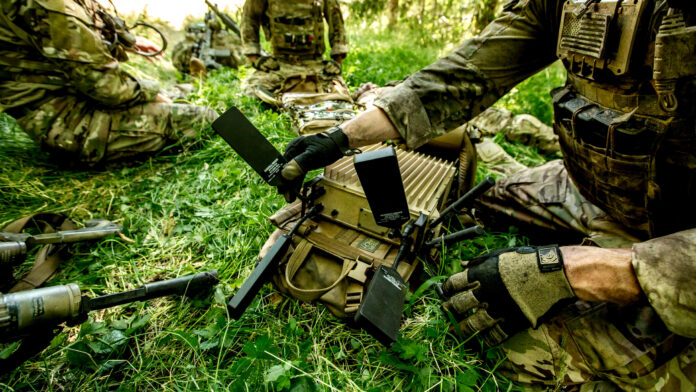Nokia has completed a deal to buy US-based defense-comms specialist and integrator Fenix Group. The agreement was originally announced at the end of last year. The acquisition, now ratified in a Committee on Foreign Investment in the U.S. (CFIUS) review, has been a strategic play for the Finnish vendor in the formation of its Nokia Federal Solutions unit, created in January to sell private cellular, edge computing, and other critical connected solutions to the U.S. federal government. The value of the deal has not been disclosed.
Fenix Group, acquired from Washington DC-based private investment firm Enlightenment Capital, sells tactical broadband (or “broadband tactical communications”, or “battlefield communications”) products to the U.S. defense sector. These include its own Banshee and Talon lines of portable / static private LTE radios and edge computing equipment for ‘mobile ad-hoc networking’ (MANET) in battle zones. Nokia is adding the Banshee and Talon products to its own private-edge technology portfolio, to hone its focus on the U.S. defense sector.
On its website, Fenix Group writes: “Our mission is to reduce risk and cost to the warfighter by enabling battlefield intelligence at the edge, increasing soldier lethality and allowing smaller teams to control larger areas. Our experience in deploying specialized communication systems in austere environments, enabling a ‘Battlefield of Things’, allows U.S. to connect drones, augmented reality enabled battlefield robots, loitering munitions and other sensor ecosystem endpoints to enable military and first responders with at-the-edge data and intelligence.”
Fenix Group also sells communications equipment for mission-critical operations to industrial customers.
Nokia already offers a portable private LTE/5G solution, Nokia Perimeter Network (NPN), which fits in a bag and is customized and resold by partners – mostly for emergency services and disaster recovery. Its NPN product sits alongside its macro-sized Modular Private Wireless (MPW) product for wide-area projects and its expanding three-tier Digital Automation Cloud (DAC) product for enterprise campus projects. It said in March that it was readying an ‘ultra-compact’ DAC product, as yet unnamed, to support a couple of radios, and compete with Wi-Fi in small venues.
It already has a DAC Compact version, launched last year, for up to four radios in small-to-mid sized indoor venues (up to 20,000 square meters). The original DAC solution, which has fuelled most of Nokia’s sales, supports up to 100 cells in campus setups (over 20,000 square meters). Nokia said the new deal is a “milestone” in its U.S. strategy, as a “trusted provider of secure and innovative solutions to the U.S. federal government”, and also a means to offer a “more comprehensive suite of 3GPP-based solutions to defense customers worldwide”.
Fenix Group is “established” with the U.S. Defense Department, and Nokia is “well-positioned to further expand” its own role with the same. The two companies have history, too. Nokia and Fenix were jointly selected by the U.S. Defense Innovation Unit (DIU) in October 2021 for a programme, they said. “The mission was to provide ad hoc tactical private wireless communications bubbles. The combination of Nokia and Fenix supports the objective of bringing dual-use technology capabilities to the warfighter,” they said in a statement.
Mike Loomis, president of Nokia’s federal solutions business in the US, said: “The closing of the Fenix Group acquisition marks a significant step forward in our strategy to grow our defense business, as well as our overall U.S. strategy. Fenix’s expertise in broadband tactical communications perfectly complements our existing offerings, and together we will be even better positioned to deliver high-performance, secure, and reliable solutions to our defense customers, helping them achieve mission-critical objectives.”
Dave Peterson, chief executive at Fenix Group, said: “We are excited to officially join forces with Nokia. By combining our innovative solutions with Nokia’s global reach and resources, we can create even greater value for our customers and make a significant impact on the future of secure military communications.”
Nokia Federal Solutions is “underpinned” by Nokia Bell Labs, the company’s industrial research and scientific development company. Solutions for U.S. federal agencies will draw on its portfolio of IP routing, optical networking, and microwave solutions, alongside private (and tactical private) LTE/5G technologies. Nokia is also selling industrial edge hardware, plus solutions like drones. The new unit is being staffed by experts in commercial and government communications technologies, as well as professionals familiar with the workings of U.S. government agencies.
Rival vendor Ericsson has a similar tactic in the US. In March, it established a new federal division to deliver “5G-driven digital transformation” across multiple agencies in the U.S. federal government. Ericsson’s new unit is called Ericsson Federal Technologies Group (EFTG), and is geared to sell “solutions for… complex communications challenges”. It said it meets U.S. requirements for 5G networks, including for open RAN technologies and equipment Made in the USA (“of U.S. and imported parts”) from its Texas “USA 5G Smart Factory”.

